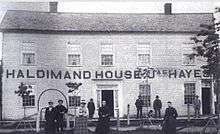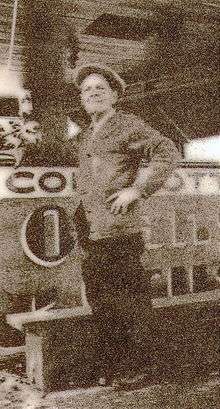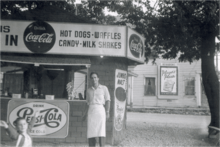Haldimand House
Haldimand House, located in the heart of Caledonia, Ontario is one of the town's oldest and most prominent local landmarks.
Early years
The history goes back to 1834 when Ranald McKinnon was hired by the Grand River Navigation Company to construct Caledonia Dam and Lock number 3 at Caledonia. At this time the town was just a small village with buildings clustered around the corner of what today is Argyle Street North and Caithness Street. When McKinnon came to Caledonia it was a vast wilderness, with only this main corner cleared and settled. There was a tavern owned by a Mr. Bryant, and a log cabin owned by a native man.[1] The south side of the Grand River at Caledonia had not yet seen any development. McKinnon, after completing the dam and lock for the Navigation Co., decided to settle in Caledonia and bought up tracts of land on the north side of the river. He started industry in Caledonia with the construction of three water-powered mills. One for flour, one for textiles, and a saw mill. It wasn't until McKinnon pushed for the Hamilton-Port Dover Plank

Road to cross the Grand River at Caledonia that South side development became feasible. James Little was an Irish immigrant to the Dominion and settled in the Seneca Village (just East of Caledonia, past the present day Fairgrounds). Little was post-master for Seneca, Caledonia and Oneida, and owned a saw mill and feed mill in the Seneca Village. When he heard of the Hamilton- Dover plank Road crossing in Caledonia he took a chance and petitioned the government to purchase lots of land on the south side of the river at Caledonia. In 1836 he started construction on his first Caledonia business venture, a stagecoach inn, which he would call Haldimand House after Sir Frederick Haldimand, Governor of Upper Canada at the time. Shortly after beginning construction on Haldimand House, Little received his Crown patents and was legally given possession of the land he was developing.[2] Haldimand House was built three stories high using squared timbers cut at Little's Seneca saw mill. Just before finishing construction, Little had his Seneca house moved off its foundation and put on a barge to be pulled up-river and added to the back of Haldimand House.
On The Stagecoach Route
Little finished construction just as the first bridge across the river in Caledonia was completed. He opened shop in 1842. The business boomed early on as one of the main stops on the stagecoach route between Hamilton and Port Dover. The hotel quickly built up a reputation for famous ciders.[3]
Little moved his post office into Haldimand House in 1842, but was petitioned by the locals to move it back into Seneca on the North side of the river. The postmaster general ordered he comply with the petition. Later that year Little sold Haldimand House to Bridget Britton. Britton added his name to the stenciled 'Haldimand House' on the facade of the Building. It now read 'Haldimand House B. Brittons'. During Britton's control of the building, a portion was used for the campaign office of William Lyon McKenzie in his campaign for the Haldimand bi-election of 1851. McKenzie won this election and a party was held in Haldimand House to celebrate. Britton sold Haldimand House to the Sutherland family in the late 1860s. They owned it until 1870, when it was sold to James Hayes. The Britton's name was removed and the facade now read 'Haldimand House J'AS Hayes'
Hayes continued to operate Haldimand House like it had been run for almost 50 years before as a hotel and bar. He died in 1900, and his daughter, Miss Maggie Hayes, sold the building on August 1, 1900 to Mr. Matthew Richardson and family.[4]

The Richardson Family
The Richardson's continued to operate Haldimand house as a hotel and bar until the early 1900s when the hotel license was cancelled. For the decades Canada was at War Haldimand House served as a boarding house for soldiers before they were shipped overseas to Europe. Mrs. Richardson ran a strict household, and was frequently upset by muddy sheets and messes created by her military guests. In the 1920s prohibition struck Ontario, and the bar was closed in Haldimand House. In 1927 Matthew's son Walter took over the management of Haldimand House. He opened a billiard hall in the old bar and constructed the Cone Cottage Refreshment stand, which would later become The Oasis in the 1950s.[5]
In the early 1950s, after Walter's death, Haldimand House was split into five apartments: two on the first and second floor and one on the third. In 1959 there was a fire on the top floor apartment caused by Mrs. Caroline Richardson lighting her gas furnace. The fire was prevented from spreading past the second floor. Leslie Richardson had just returned home five hours before the fire from a vacation in Mexico. He went to sleep at 7am, and was woken up at 12 noon by his mother, who told him about the fire. Les was a boy scout leader in Caledonia, and his troop of boy scouts along with several cub scouts showed up to Haldimand House and assisted removing large numbers of books and small objects to prevent smoke and water damage.[6] At this time the dormers were added to the third-floor roof line.
Recent years

In 1991, when Leslie Richardson (Walter & Caroline's son) died, Haldimand House was sold to Louis and Chris Leousis whose family had run the Oasis since 1956. In the early 1990s Chris ripped out the first floor apartments and uncovered the original plank flooring and tin ceilings and walls from the days of the old hotel.
In 1992 Haldimand House was opened as a gift and antique store. Through the 1990s the Leousis's spent many hours renovating and restoring Haldimand House. In 1995 the Haldimand House Beanery and Cafe was opened in the section of the building which was once James Little's House. In the 2000s a changing demographic and political issues in Caledonia required a change to the business. The Cafe was closed in 2006 and the gift and gift basket business was discontinued. In 1936, the Caledonia Candy Company was started by the Vlachos family in Caledonia. In the 1990s, Louis Leousis and son Chris revived the business and manufactured brittle, brickle, almond bark, and a variety of chocolates and treats. In 2014 Alex Leousis (daughter of Chris and granddaughter of Louis) and long time employee and friend of the family Ian Thompson once again revived the Caledonia Candy Company after several years of hiatus.
Today Haldimand House features Haldimand Counties best selection of antique furniture and accessories. Including three full rooms of fine, primitive, and 'restoration necessary' furniture. Haldimand House stands as a reminder of Caledonia's significance along the Grand River Navigation Company canal and the Hamilton-Port Dover Plank Road.
Location
Haldimand House and Oasis Drive-In are located at 22 Argyle Street South, Caledonia, Ontario Canada.
References
- Martindale, Barbara (1995). Caledonia Along the Grand River. Toronto Ontario: Natural Heritage. ISBN 0-920474-81-0.
- Corlis, Anne (1959). Caledonia & District, A History. Caledonia, Ontario: Grand River Sachem.
- Farquharson, Jean (2010). Stories Along the Grand. York, Ontario: York Grand River Historical Society. ISBN 978-0-9865284-0-8.
- Martindale, Barbara (1986). Bridging the Past. Tillsonburg Ontario: Otterville Publishing. ISBN 0-921615-01-9.
- Gillespie, Evelyn (1967). Caledonia's Century Homes. Caledonia, Ontario: Grand River Sachem.
- Sercomb, Frank (October 3, 1959). "Built 1834, Stage Coach Inn Falls to Fire in Caledonia". The Hamilton Spectator. p. 4.